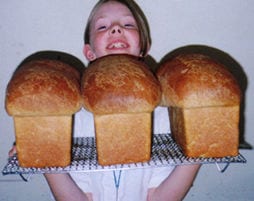The Bread Story
Factory bread is bland. It engenders bland.
Rather than being a taste itself, bread has become a convenient medium on which to array others flavours. Butter and its chemical substitutes, jam or other sugary pastes have become more significant to our modern palettes than the deep and satisfying flavour of real bread….what a thing to miss out on!
Today’s real bread is home-baked with good quality flours, from grains that can be home-milled. It excludes, of course, the additives and chemicals which have taken over the bakery trade. There is no doubt that bleached white flour is devoid of the nutrients contained in wholemeal flour. Even when bread made from bleached white flour is enriched to replace what are considered to be the most vital nutrients, there are other important substances which are not replaced.
Food which is artificially separated and denatured cannot be wholesome. The issue of whether today’s white bread is suitable for human consumption or not is also clouded by the fact that most of the so-called ‘wholemeal’ breads on sale today are no better. They are usually made from dyed white dough, with some bran thrown in for good measure, or artificially inflated by the use of gluten flour. The best wheat is organically grown and the best flour stoneground from such wheat. The colour, flavour, aroma and effect on the final product are unmistakeable, and still retains the aroma of wheat. Heavily processed or chemicalised flour does not have this aroma. It can’t be measured by anyway other than by our human senses, so smell your flour. Grinding flour yourself from fresh, organic wheat will give you a standard – then go on to one of the commercial flour substitutes, you will soon know the difference.
Commercial white flour has had most of the bran and germ removed by sifting, and the residue destroyed by the bleaching process which gives it an artificial whiteness supposedly preferred by consumers.
One can, pick-up a supposed ‘stoneground wholemeal’ loaf expecting it to have some weight, and hurl it to the roof because of its surprising lightness. It weighs only 680g!
A loaf of the same volume made with real flour weighs 1 and a 1/2 to 2kg.
While some good bread can still be bought, it does become clear that the only way we can be sure that we will be eating a nutritious loaf of bread, is to mill our own grain and bake it within 72 hours before it would go rancid. We at this point, take control of our health. And there is no question that the best bread is made from freshly ground flour.
Owning a good stone mill makes it possible to grind various meals which can be used in bread and are not widely available.

